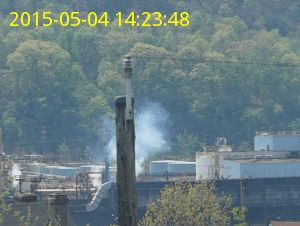THE CONSTELLATION PRIZE
reimagining what engineering is for
The Shenango Channel: A Collaboration between
the CREATE Lab and ACCAN
Winners of the 2020 Constellation Prize for Community Collaboration

From left to right: Thaddeus Popovich (ACCAN), Yen-Chia Hsu (CREATE Lab), Kathleen Krebs (ACCAN), and Angelo Tarrant (ACCAN)
“We were willing to be on the front lines, go to public meetings and voice our complaints, but it's easy for people to ignore the activists. The documentation that the CREATE Lab helped us develop was huge. [Our concerns] couldn’t be ignored anymore.”
~Angelo Taranto, ACCAN Organizer
Since the 1980s, Allegheny County Clean Air Now (ACCAN) had fought for the closure of DTE Shenango Coke Works, an extraordinarily polluting industrial facility in Pittsburgh. It was a creative collaborative effort with the CREATE Lab at Carnegie Mellon University that finally shuttered the plant for good, and it is this collaborative effort we acknowledge through the Constellation Prize.
A community resident once asked Randy Sargent, Visualization Director of the CREATE Lab, “Is it safe for my kids to be outside right now?” Sargent says, “I couldn't answer the question...I was the expert, but not the one she needed. That moment changed me.”
Together, ACCAN and the CREATE Lab developed “The Shenango Channel,” a web-based system used to publish and visualize air pollutant measurements, smell complaints and videos of fugitive emissions released by the Shenango Coke Works. Yen-Chia Hsu, a post-doctoral researcher in the CREATE Lab, developed a visual detection and analysis method to determine the worst pollution events. Based on this work, Hsu determined that DTE Shenango Coke Works exceeded permitted emissions limits every 5 of 7 days.
At a public meeting in 2015, Hsu showed 140 people, including the US Environmental Protection Agency and Allegheny County Health Department officials, montages of polluting events like the ones below that had long gone unnoticed by regulators.


At a public meeting in 2015, Hsu showed 140 people, including the US Environmental Protection Agency and Allegheny County Health Department officials, montages of polluting events like the ones above that had long gone unnoticed by regulators. (Images and language pulled directly and verbatim from www.shenangochannel.org)
“A month later, we heard the plant was shutting down,” says Angelo Taranto, a long-time ACCAN organizer.
“[The Shenango Channel] exemplifies successful collaboration between engineers and a "frontline" community and shows how thoughtfully co-designed technology can empower citizens to advocate for social change” said Gwen Ottinger, an Associate Professor in the Department of Politics at Drexel University, and nominator.
For details on The Shenango Channel, press coverage, and the research behind the effort, click here.
May 27, 2015: Brown, orange, yellow, blue and black emissions: Toxic organics condense into various colors when battery is allowed to vent directly to the air. These heavy organics are carcinogenic at minute levels, and include high levels of PAHs, which recent studies associate with autism. Black smoke can come from burning raw coke oven gas, and other black and grey emissions can be escaping coal or coke. All are toxic when inhaled.
June 11, 2015: Despite promises to install power backup equipment, DTE Shenango lost power yet again, triggering emergency venting and flaring for 53 minutes. Avalon, Bellevue, the North Side, Lawrenceville, O'Hara and Fox Chapel were downwind and bore the brunt of the toxic and carcinogenic emissions.
Leah Andrascik of Avalon: "We could smell the noxious odors filling the air. I’m appalled that my two young children and many others in our community were exposed to raw coke oven gas and the many other unprocessed emissions that were released into the air that evening."